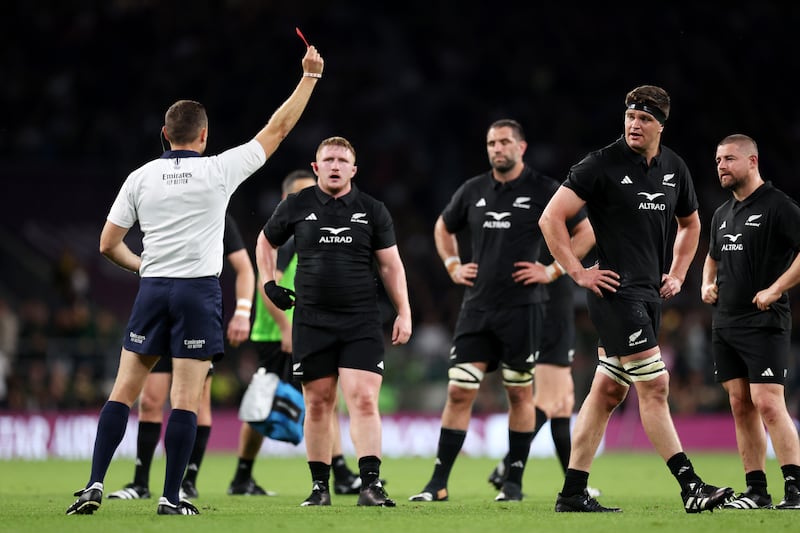Friday evening at Twickenham: South Africa v New Zealand.
In selecting seven forwards on the bench, and only one back, South Africa made a statement of intent, which was to pummel New Zealand into submission. When these men arrived just after the start of the second half, en bloc, it was not just a bomb squad, it was the entire battalion.
Keith Wood – and he should know – compares the arrival of these squads to a heavyweight boxer, nearly out on his feet, looking up from his stool between rounds and seeing a new, fresh opponent in the opposite corner. So, how safe can it be to send out what is basically a whole new pack to compete against fatiguing opponents?
Replacements were originally intended to provide cover for injury and to ensure that the three specialist frontrow positions were covered, thus avoiding uncontested scrums. Where it has all gone since was never foreseen which is, of course, the law of unintended consequences at work. It’s time for a change.
READ MORE
Many will agree with Wood that the number of replacements should be lowered, but if World Rugby insists on continuing with eight, there should be a maximum number of forwards allowed – say a maximum of five, while four would be better still. When things get out of hand it’s time to write a new docket, although the coaches will rant and rave against any such alteration. Player safety and welfare must be prioritised, as we are frequently reminded by those at the top table.
New Zealand were demolished. And if anyone ever doubted South Africa’s ability to have a real go at retaining the Webb Ellis Cup, well, doubt no more.
Despite New Zealand coach Ian Foster telling us that his team would be at “full throttle”, they never emerged from first gear. The South Africa pack, on the other hand, knowing that they’d only have to keep going for half the match, slammed their collective foot to the floor and emptied the tank, to the point where the All Blacks looked battered and bewildered. Sam Cane may have his good points as captain, but he is certainly not an inspirational leader in the mould of Richie McCaw.

Yellow cards for Scott Barrett and Cane should really have been delivered earlier, as New Zealand constantly infringed in an effort to stem the tsunami engulfing them. And then a second yellow for Barrett added up to red. This yellow was for foul play, but we were not told by the bunker if it was also a stand-alone “red”, which it definitely looked like. Having already faced the judiciary, Barrett’s parents named him well, he’s avoided a suspension, off scot-free.
[ Father of All Blacks’ Barrett clan has plenty to smile aboutOpens in new window ]
There have been five or six red cards in these warm-up matches, all very clear and obvious decisions, which would have been easily made by the referee if the bunker was not in play. This compares to a record total of seven reds in the last World Cup. If coaches and players have learnt nothing, then they will threaten that record – the referees and the bunker are not going to change how they do their business.
Meanwhile, South Africa have been exercised about Ireland’s so-called “cannon arm”. A television panel, including former coach Nick Mallett, carefully explained that it was used during the URC by the Irish provinces, and why they see it as illegal. It is also very difficult to defend against.
It happens when the ball carrier, driving low, holds the ball in one arm, using his other arm (on the ground) to balance himself, or to propel himself forward – a sort of fast crawl, if that’s not too much of an oxymoron.
In reality, they have a valid point, the “cannon arm” ball carrier is not supporting his body weight legally, therefore forward movement using this technique should be penalised. However, using that other arm to momentarily balance or re-balance himself, seems okay to me.
On Saturday, again at Twickenham, we witnessed Fiji sundering England. The chariot was in full retreat, in an easy enough assignment for the relaxed Jaco Peyper, who will face a very different challenge when France and New Zealand open hostilities on Friday week.
He and television match official Brian MacNeice found no evidence of head contact in Joe Marler’s upright tackle on Fijian Albert Tuisue. What we saw looked like there had been, and Tuisue was obviously suffering badly from the blow. The optics would have looked a lot better if the officials had taken more time to investigate why the player was laid out, then they might well have concluded “yellow card threshold reached”, and sent it to the bunker.
Fiji were perplexed, annoyed that this did not get the attention it deserved. And they were right. The incident also places a major question mark opposite the assurances that England have been working hard at changing their tackle technique. With Argentina next up, they still have much to do.
















